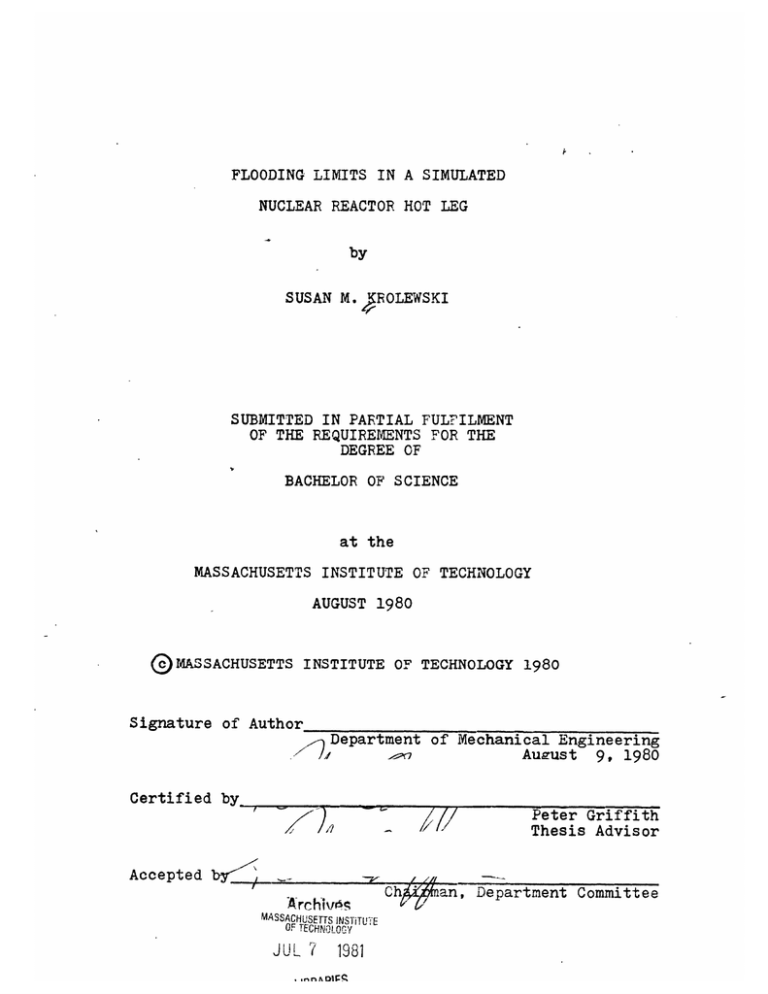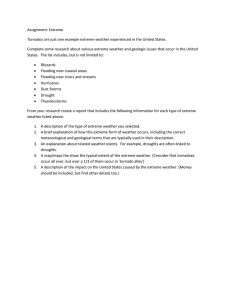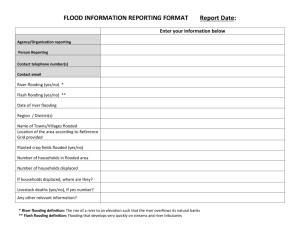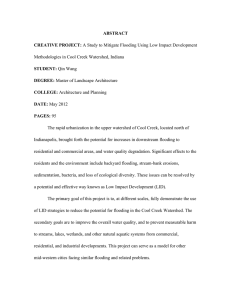(MASSACHUSETTS
advertisement

FLOODING LIMITS IN A SIMULATED NUCLEAR REACTOR HOT LEG by FOLEWSKI SUSAN M. SUBMITTED IN PARTIAL FULFILMENT OF THE REQUIREMENTS FOR THE DEGREE OF BACHELOR OF SCIENCE at the MASSACHUSETTS INSTITUTE OF TECHNOLOGY AUGUST 1980 INSTITUTE OF TECHNOLOGY 1980 (MASSACHUSETTS Signature of Author Department of Mechanical Engineering August 9, 1980 Certified by WASW V Peter Griffith Thesis Advisor 219 Accepted by Archivs MASSACHUSE OF 7 NTiTUTE 1y JUL 7 1981 LIBRAIES Ch * ' an, Department Committee FLOODING LIMITS IN SIMULATED NUCLEAR REACTOR HOT LEG by SUSAN M. KROLEWSKI Submitted to the Department of Mechanical Engineering on August 9, 1980 in partial fulfillment of the requirements for the Degree of Bachelor of Science in Mechanical Engineering ABSTRACT During a small break LOCA one mode of decay heat removal is reflux cooling. When this occurs steam is evolved in the core, passes to the steam generators, is condensed and the condensate returns through the hot leg to the core. Experiments were performed to determine the flooding limits for two phase air/water flow in a simulated nuclear reactor hot leg. Since there is no standard hot leg geometry, five different configurations were tested. It was found that the geometry of hot leg had a significant effect on the flooding limits. Flooding data plotted on basis of square roots of the non-dimensional superficial velocities for one configuration was compared with the results observed by Wallis (1969) for vertical tubes with reasonable agreement. The range of hystersis, however, was unusually high and possibly a function of change in flow from open channel supercritical to subcritical. Thesis Advisor: Professor Peter Griffith - 2 - TABLE OF CONTENTS Abstract 2 List of Figures and Tables 4 Nomenclature 5 Introduction 6 Apparatus 9 Experimental Procedure 18 Results 19 Conclusions 29 Acknowledgements 30 References 31 LIST OF FIGURES AND TABLES Figure 1. Schematic Diagram of the Primary System of a Two Loop PWR 10 Figure 2. Configuration A of Test Section 11 Figure 3. Configuration B of Test Section 12 Figure 4. Configuration C of Test Section 13 5. Configuration D of Test Section 14 Figure 6. Configuration E of Test Section 15 Figure 7. Experimental Setup 17 Figure 8. Flooding Curve for Configuration 20 Figure 9. Flooding Curve for Configuration 21 Figure 10. Flooding Curve for Configuration 22 Figure 11. Flooding Curve for Configuration 23 Figure 12. Flooding Curve for Configuration E 24 Figure 13. Composite Plot of Flooding Curves as J is Increased For Configurations A, B, C, D and E. 25 Flooding Curve Based on Dimensionless Superficial Velocities for Configuration E 27 Table 1. Effect of Liquid Froude Number on Range of Hystersis For Configuration E 28 Figure 15. Schematic to Illustrate Calculation of Liquid Froude Number 27 Figure Figure 14. - 4 - NOMENCLATURE ATOTAL Total Cross sectional Area of Pipe (FT ) AWATER C Water Filled Cross Sectional Area of Pipe (FT ) Y-intercept of Non-dimensional Superficial Velocity Flooding Curve D Diameter of Pipe (FT) Fr Froude Number g Gravitational Acceleration (32.2 FT/SEC 2 ) h Height of Water in Square Channel (FT) hMA Height of Water in Pipe (FT) JF Superficial Velocity of Water (FT/SEC) JG Superficial Velocity of Air (FT/SEC) JF* Non-dimensional Superficial Velocity of Water JG* m Non-dimensional Superficial Velocity of Air Slope of Non-dimensional Superficial Velocity Flooding Curve NL Grashoff Number Q Volumetric Flow Rate (FT3/SEC) R Radius of Pipe (FT) u1 Liquid Viscosity V Velocity of Water (FT/SEC2 ) fF fG Density of Water (LB/FT 3 ) 3 Density of Air (LB/FT ) - 5 - INTRODUCTION It is essential for all nuclear reactors to continuously provide sufficient cooling to the core in order to prevent destruction of the clad and the release of radioactive materials to the environment. The emergency core cooling system (ECCS) in a PWR is designed to provide adequate core cooling after an accident. If the coolant level in the core decreases,ECCS water is injected into the core from storage tanks through the cold legs. The ECCS, however, can not provide infinite water supplies to the core. Due to its infrequent use, it is also prone to mechanical malfunctions. It is therefore worthwhile to investigate 'additional means of core cooling that would not require additional equipment. A loss of coolant accident (LOCA) is caused by a break in one of the primary recirculation loops. A rapid depressurization from approximately 2200 psi to containment pressure causes flashing of primary coolant to steam. As a result of this, the primary coolant exists as a two phase mixture of steam and water. One mode of cooling that has been postulated is that steam will be evolved and travel out of the core through the hot leg and into the steam generator and then condense. The condensate would then flow down the steam generator, collect at the bottom and eventually flow back to the core through the hot leg. The condensate could then augment the ECCS reflood process. There are two limitations on the mass flow of condensate - 6 - flowing back to the core. The first involves the heat transit~r capabilities of the steam generator. The second is the limit of countercurrent steam/condensate flow possible in the hot leg region of the primary coolant system. This limit is defined as flooding. Beyond the flooding point, increasing the flow of either phase will cause either a change in flow regime or a rejection of excess material at the ends of the flow passage. The flooding point is the result of a sudden and dramatic instability which increases the pressure gradient by an order of magnitude. Wallis(1969) used an empirical approach to correlate flooding data for flow in vertical tubes. Wallis based his correlations on the non-dimensional superficial velocities, JG* and JF*, defined by GG F G gD( F"|OG) and JF F JF I gD( F_/4G) JG* and J* are analogous to the Froude number, Fr, which represents the ratio of inertial forces to gravity forces and is given by Fr According to Wallis, the flooding points for vertical pipes are given by C 1- J G*2 JF *2 =C -7?F- where m is the slope and C is the y-intercept of the nondimensional flooding curve. The slope and the y-intercept are related to the Grashoff number, NL, which represents the ratio of gravity forces to viscous forces and is given by /PFgD3 (PFG) NL UL2 For high NL, the gravity forces are more significant, m is almost unity and .75-4-C <1. For small NL, the gravity forces are less significant, m-=5. 6NL 2 and C is a function of the inlet and outlet conditions. Some hystersis was observed in many flooding experiments. The air flow rate, JG, had to be reduced before the tube would return to smooth operating conditions. The range of hystersis was between the lines JF + JF* + JG 1 and *.88 The geometry of hot legs, however, is more complicated and varies from nuclear reactor to reactor. It is not certain whether Wallis's correlations can be used to determine flooding limits in hot legs. This thesis will experimentally determine the flooding limits of two phase air/water flow in five geometrically different simulated nuclear reactor hot legs and compare the results to Wallis's correlations. - 8 - APPARATUS The test apparatus models the countercurrent two phase flow of steam and condensate in the hot leg region of the reactor primary coQlant system. Figure 1. is a schematic diagram of a primary system of a typical C-E two loop PWR and indicates the section modelled by the test apparatus. Since only the fluid mechanics aspect was of interest, the steam/condensate flow was simulated by air/water flow. The test section of the apparatus was constructed from two inch diameter plexiglass tubing and PVC fittings. Plexiglass was selected primarily to allow for flow pattern observation. Since not all reactors have the same primary loop geometry, five different pipe configurations as shown in Figures 2, 3, 4, 5 and 6 were used. In each case a 24" horizontal section of pipe simulated the hot leg piping. One end was connected to a elbow and pipe configuration simulating the different entrances into the steam generator. The pipe was directed upward through a metal container simulating the bottom of the steam generator. On the other end of the horizontal pipe, two different fitting and pipe combinations were used to simulate the junction of the hot leg with the core. This end was directed downward and submerged in a weigh tank simulating the core. To simulate the flow of condensate down the steam generator, water was poured into the metal container and allowed to pour over the sides of the piping. The mass flow rate was -9- I L ~ TEAM CORE - FIGURE 1. SCHEMATIC DIAGRAM OF THE PRIMARY SYSTEM OF A TWO LOOP PWR - 1- 12"-2" DIA. PLEXIGLASS PIPE W/ 2" SEMICIRCULAR SECTION REMOVED 900-2" DIA. PVC ELBOW 23"-2" DIA. PLEXIGLASS PIPE 900-2't DIA. PVC ELBOW 20"-2" DIA. PVC PIPE FIGURE 2. CONFIGURATION A OF TEST SECTION - 11 - FIGURE 3. CONFIGURATION B OF TEST SECTION - 12 - 12'-2" DIA. PLEXIGLASS PIPE W/ 2" SEMICIRCULAR SECTION REMOVED 2"-4" DIA. PVC ENLARGER 2" DIA. PVC FEMALE ADAPTER '-2" DIA. ELBOW 23"-2" DIA. PLEXIGLASS PIPE 900-4" DIA. PVC ELBOW 13"-4" DIA. PVC PIPE FIGURE 4. CONFIGURATION C OF TEST SECTION - 13 - 6" DIA. PLEXIGLASS PLATE W/ 2" DIA. HOLE 2"-4" DIA. PVC ENLARGER 2"DIA. PVC FEMALE ADAPTER 10"-2" DIA. PLEXIGLASS PIPE 900-2" DIA. PVC ELBOW SMOOTHED W/ PLASTICENE 23"-2" DIA. PLEXIGLASS PIPE 9 0 0-4" DIA. PVC ELBOW 13"-4" DIA. PVC EPIPE FIGURE 5 CONFIGURATION D OF TEST SECTION - 14 - 6" DIA. PLEXIGLASS PLATE W/ 2" DIA. HOLE 2"-4" DIA. PVC ENLARGER 10"-2" DIA. PLEXIGLASS PIPE 2" DIA. PVC FEMALE ADAPTER 450-2" DIA. PVC ELBOW SMOOTHED W/PLASTICENE 23"-2" DIA. PLEXIGLASS PIPE 9 00-4" DIA. PVC ELBOW 13"-4" DIA. PVC PIPE FIGURE 6. CONFIGURATION E OF TEST SECTION - 15 - determined by weighing the accumulation in the weigh tank over a measured time period. To simulate the flow of steam, air was injected into the system through an inlet tube located in the vertical pipe submerged in the weigh tank. Air flow rate was -measured by two Fisher and Porter flowmeters, FPi-27-G-lo/55 and FP-1-35-6-io/83 hooked up in parallel. They were used for low and high ranges of air flow respectively. Since the flowmeters were calibrated at atmosphere, it was necessary to determine the operating pressure of the system. A mercury manometer was attached to the inlet of the two flowmeters to determine the operating pressure. The operating flow rate was equal to the flow rate at atmospheric pressure times the square root of the operating pressure divided by the atmospheric pressure. A water manometer was attached to the bottom of the horizontal plexiglass section to determine the pressure of system as water and air velocities were varied. Two small diameter taps were drilled into the top and bottom of the horizontal plexiglass tubing. A piece of polyflow tubing was connected between each hole and the end of a i inch diameter vertical glass tube which was mounted along side the test section. The tube was used to determine the level of water in the horizontal pipe. A valve was placed at the top of the glass tube to permit damping of rapid height oscillations. Figure 7 shows the entire experimental setup. - 16 - FIGURE 7. EXPERIMENTAL SETUP - 17 - EXPERIMENTAL PROCEDURE Tests were performed to determine the air flow rates which initiated and terminated flooding for several different water flow rates for each of the five "hot leg" configurations. Before each test run, the water flow rate was determined by weighing a sample collected in the weigh tank over a measured period of time. The water flow rate was then held constant and the air flow was slowly increased until a sudden increase in pressure was detected on the water manometer. This change in pressure indicated that the flooding limit had been reached. The flooding location was recorded. To determine the range of hystersis, the air flow rate was slowly decreased until the pipe returned to smooth operating conditions. An additional test was performed on Configurations E to enable calculations of the liquid Froude numbers at both of the flooding limits. For five different constant water flow rates, the height of water in the vertical tube of level indicator for limit as JG is increased and the limit as JG was decreased. - 18 - RESULTS AND DISCUSSION The air flow rate, JG, was varied for several different water flow rates, JF, in each of the five configurations to determine the flooding limits. The flooding curves for various pipe configurations are shown in Figures 8, 9, 10, 11 and 12. Very definite transition points from one flooding pattern to another were observed for Configurations A, B and C. Configurations D and E flooded only at one location. The range of hystersis was significant only in configurations C and E which had 450 elbows at one end of the test section. The hystersis effect was much more significant than those reported by Wallis's. The composite plot in Figure 13 directly compares the flooding limit as JG is increased for all five configurations. According to Wallis, the flooding curve slope and y-intercepts are directly related to the liquid viscosity, the density of liquid and gas and the geometry of the pipe. Since the fluid properties are identical for all five configurations, the differences in the flooding curve are due to the change in geometry. The transitions from one flooding pattern to another is also indicated in Figure 13. Changes in flooding location cause a slight change in the slope of flooding curve. The flooding limit for each pipe fitting is probably slightly different. The configurations floods at the lowest limit. When flooding occurs at two locations at once the water flow rate limit is slightly higher since water is partially held - 19 - NOTES 14 * FLOODING ORIGINATES AT 1-2 AND SPREADS TO 13 3-4 O FLOODING OCCURS AT 3-4 ONLY 6 12 11 13 2 E-4 Irz4 10 9 FLOODING POINT AS J IS INCREASED FLOODING POINT AS JG IS DECREASED 0 >_4* E-4 71- 0 0 FAI I ** 31- cI c.1 .2 .3 .4 .5 .6 SUPERFICIAL VELOCITY OF WATER, JF ( FT/SEC) FIGURE 8. FLOODING CURVE FOR CONFIGURATION A - 20 - .7 NOTES 14 o FLOODING OCCURS AT 3-4 ONLY @ FLOODING ORIGINATES AT 5-6 AND SPREADS TO 3-4 6 13 12 4 34 G2 -10 E-4 FLOODING POINT AS JG ISINCREASED 10 FLOODING POINT AS JG IS DECREASI D I E-4 c 0 III 41 @ I-4 InI I ) I .1 I I I .2 .3 .4 I I .5 .6 SUPERFICIAL VELOCITY OF WATER, JF (FT/SEC) FIGURE 9. FLOODING CURVE FOR CONFIGURATION B - 21 - I NOTES o FLOODING OCCURS AT 3-4 ONLY @ FLOODING ORIGINATES AT 5-6 AND SPREADS TO 3-4 14 * FLOODING ORIGINATES AT 1-2 AND SPREADS TO 3-4 13 # FLOODING OCCURS AT 5-6 ONLY 12 11 10 9 0 .. E-1 0 PC 4 FLOODING POINT AS JG IS INCREASED FLOODING POINT AS JG IS DECREASED .1 .3 .2 .4 .5 .6 SUPERFICIAL VELOCITY OF WATER, J, (FT/SEC) FIGURE 10. FLOODING CURVE 'FOR CONFIGURATION C - 22 - .7 NOTES 14 o FLOODING OCCURS AT 3-46 0NLY 135 4 ~1110 3 2 12 I FLOODING POINT AS JG IS INCREASED FLOODING POINT AS JG IS DECREASED 9 5 6 7L L 3 - - 2 - 0 - .2 .3 .4 .5. .6 SUPERFICIAL VELOCITY OF WATER, J (FT/SEC) F FIGURE 11. FLOODING CURVE FOR CONFIGURATION D - 23 - .7 NOTES 14 o FLOODING OCCURS AT 3-4 ONLY 13 12 ;11 E410 rM14 14I~ ii FLOODING POINT AS JG IS INCREASED 0 ? ?9 FLOODING POINT AS JG IS DECREASED 9 9 o 0? t14 0 E-4 6 n4 914 3 1~ 2 1 0 .2 . SUPERFICIAL VELOCITY OF WATER, JF FIGURE 12. (FT/SEC) FLOODING CURVE FOR CONFIGURATION E - 24 - TRANSITION POINT BTW ( 14 - FLOODING PATTERNS 13 12 EHE o1- D 9 - rL4 0 8 E o7 C 6 5 p 4 3 2D 1 0 .1 .3 .2 .4 .5. .6 .7 SUPERPICIAL VELOCITY OF WATER, JF (FT/SEC) FIGURE 13. COMPOSITE PLOT 07 FLOODING CURVES AS J IS INCREASED FOR CONFIGURATIONS A,B,C,B&E - 25 - back at both locations. Configuration E is the closest geometric simulation of an actual reactor hot leg. Flooding data for configuration E was plotted on the basis of the square roots of the nondimensional superficial velocities in Figure 14 in order to compare the results to Wallis's correlation. For JF* equal to zero, JG* or C is approximately equal to five. The slope of the non-dimensional flooding curve is approximately 1.7. This is reasonably close to Wallis's predictions. Wallis found C to be between .75 and 1 and m to be unity for vertical pipes. The range of hystersis for Configuration E was excessively high. Further tests were performed on Configuration E to determine the liquid Froude numbers for the upper and lower air flow flooding limits for five different water flow rates. Wallis based his correlations on JG* and JF* which are analogous to the Froude number. For Fr greater than unity, the flow is supercritical and the force of water flow is greater than the gravity forces. For Fr less than unity, the flow is subcritical. Figure 15 illustrates the method used to calculate the Froude numbers. Table 1 compares the difference in flooding limits with the difference in liquid Froude numbers for several water flow rates. For the flow rates with the highest hystersis effects, the water flow was subcritical at the higher limit and supercritical at the lower limit. The change from subcritical to supercritical flow may account for the wide range of hystersis. 26 FLOODING POINT AS JG IS INCREASED 4 5 7- FLOODING POINT AS J IS DECREASED 04 0 .3 5 .LI 9 o 9 9 0 '9 T 01 0 *3 r-, 0 5 0 w~, 0 ,1 5 ,1 0 ,05 .4 .5 .1F .2 SQUARE ROOT OF JF FIGURE 14. FLOODING CURVE BASED ON DIMENSIONLESS SUPERFICIAL VELOCITIES FOR CONFIGURATION E. ' - 27 - TABLE 1. EFFECT OF LIQUID FROUDE NUMBER ON RANGE OF HYSTERSIS FOR CONFIGURATION E F ftft sec VALUES FOR FLOODING POINT AS JG IS DECREASED VALUES FOR FLOODING POINT AS JG IS INCREASED hmx -ftG-sec ft Fr hmax J-sec ft Fr DIFFERENCE IN JG LIMITS .10 10.5 .063 .21 9.3 .093 .12 11% .21 10.5 .093 .26 6.3 .15 .15 40% .2R 10.1 .03 .34 5.2 .10 .28 48% .39 9.3 .063 .80 3.0 .15 .26 68% .49 9.3 .052 1.37 2.1 .13 .28 77% .60 9.3 .052 1.79 1.0 .13 .36 89% .64 8.7 .063 1.33 .15 .32 93% .6 F TOTAL Fr = AWATERI-gmax SF = .0038 AWATER~1Nx h max FIGURE 15. SCHEMATIC TO ILLUSTRATE CALCULATION OF FROUDE NUMBERS - 28 - CONCLUSION The results show that the geometry of the hot leg has a significant effect on the flooding limit. The flooding limits as JG was increased for all the configurations were reasonably close to Wallis's results for vertical tubes. The range of hystersis, however, was unusually high for two of the configurations. It is possible that this is the result of a change in water flow from supercritical to subcritical as JG is decreased. Theses results suggest that further studies with geometrically identical models are needed to determine the flooding curve for a particular hot leg geometry. - 29 - Acknowledgements I would like to thank Professor Griffith for his help and encouragement. Special thanks to Fred Johnson for building and maintaining the test apparatus. - 30 - REFERENCES Fox and MacDonald, Introduction to Fluid Mechanics, John Wiley, New York, 1978. Gouse, S. William Jr., "An Introduction to Two-Phase Gas Liquid Flow", Notes for Special Summer Program in Two Phase Flow, MIT, 1964. Wallis, Graham, One Dimensional Two-Phase Flow, McGraw Hill, New York, 1969. Wallis, Graham, "Flooding Phenomena in Two-Phase Flow", Notes for Special Summer Program in Two-Phase GasLiquid Flow, MIT, 1 9 64,. - 31 -








